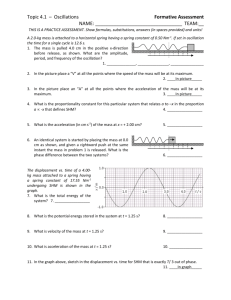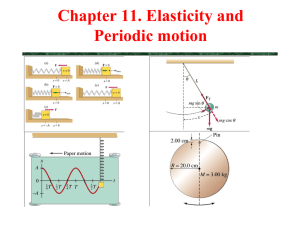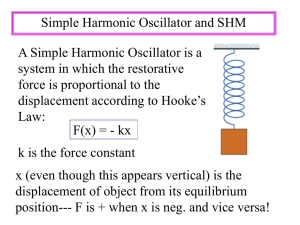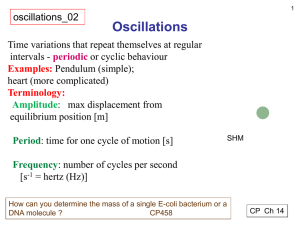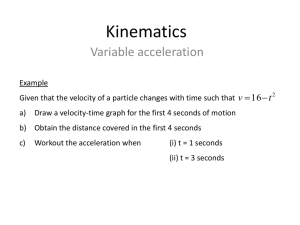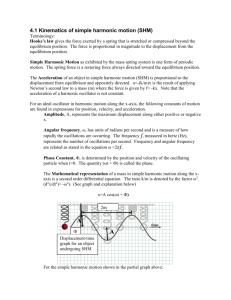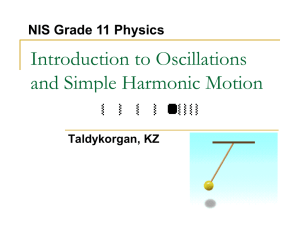Module -1 - Oscillations
advertisement
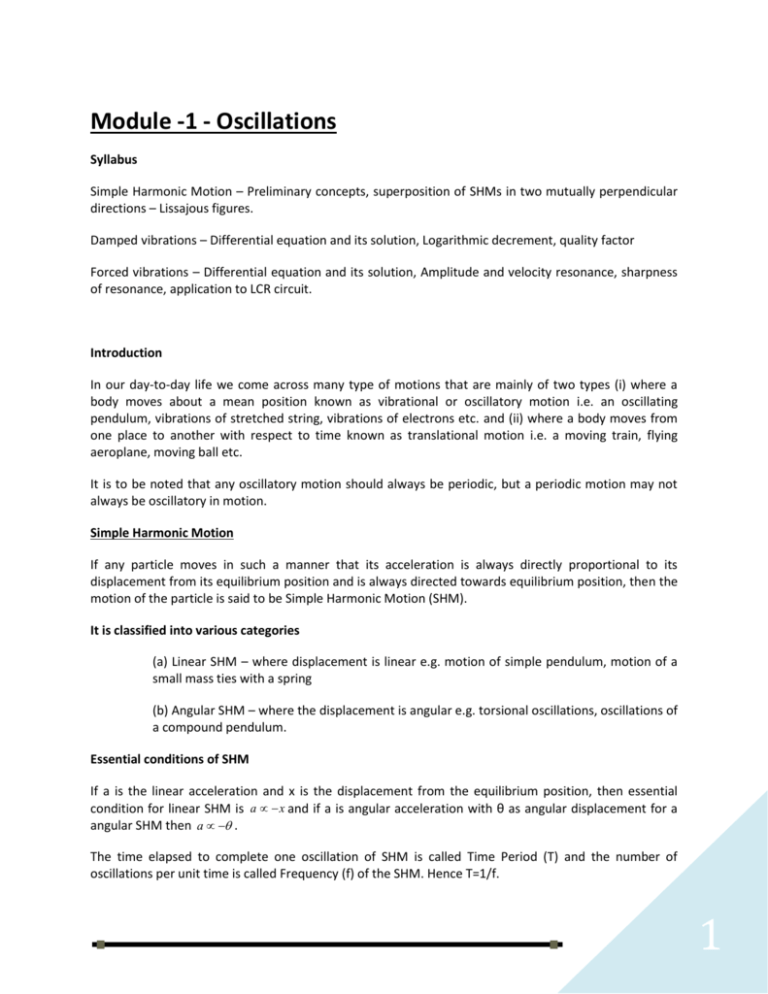
Module -1 - Oscillations Syllabus Simple Harmonic Motion – Preliminary concepts, superposition of SHMs in two mutually perpendicular directions – Lissajous figures. Damped vibrations – Differential equation and its solution, Logarithmic decrement, quality factor Forced vibrations – Differential equation and its solution, Amplitude and velocity resonance, sharpness of resonance, application to LCR circuit. Introduction In our day-to-day life we come across many type of motions that are mainly of two types (i) where a body moves about a mean position known as vibrational or oscillatory motion i.e. an oscillating pendulum, vibrations of stretched string, vibrations of electrons etc. and (ii) where a body moves from one place to another with respect to time known as translational motion i.e. a moving train, flying aeroplane, moving ball etc. It is to be noted that any oscillatory motion should always be periodic, but a periodic motion may not always be oscillatory in motion. Simple Harmonic Motion If any particle moves in such a manner that its acceleration is always directly proportional to its displacement from its equilibrium position and is always directed towards equilibrium position, then the motion of the particle is said to be Simple Harmonic Motion (SHM). It is classified into various categories (a) Linear SHM – where displacement is linear e.g. motion of simple pendulum, motion of a small mass ties with a spring (b) Angular SHM – where the displacement is angular e.g. torsional oscillations, oscillations of a compound pendulum. Essential conditions of SHM If a is the linear acceleration and x is the displacement from the equilibrium position, then essential condition for linear SHM is a x and if a is angular acceleration with θ as angular displacement for a angular SHM then a . The time elapsed to complete one oscillation of SHM is called Time Period (T) and the number of oscillations per unit time is called Frequency (f) of the SHM. Hence T=1/f. 1 The maximum displacement of particle from its mean position is called as Amplitude of SHM and the quantity which tells us about the instantaneous position and direction of motion of a SHM is known as Phase of the motion. The general equation of motion for any SHM can be given as y A sin(t ) where A is amplitude, ω as angular frequency and φ as initial phase of the motion. Hence if a particle of mass m takes SHM and x be the displacement from mean position then its acceleration a is given by a x a kx And force acting on the particle F = ma (also known as restoring force) So F mkx x (here µ=mk is called as force constant i.e. restoring force per uit displacement of the particle. Characteristics of SHM (i) motion is linear (ii) motion is periodic and oscillatory (iii) and the restoring force is proportional to and acting in the direction opposite to the displacement from mean position. Let us consider a particle moving on the circumference of a circle of radius r with a uniform velocity v Equation of SHM and its solution Let us consider a particle of mass m moving under the influence of any SHM along a straight line with x as displacement from mean position at any time t. Then using the basic condition of SHM F x or F kx where k is force constant. …………..(1) If a is the acceleration at any time t then ma kx Or m d2x kx dt 2 Replacing k/m with ω2 or d2x k x0 dt 2 m …………..(2) d2x 2 x 0 dt 2 …………..(3) Equation (ii) and (iii) are known as equations of SHM. To find its solution let us consider x Cet (where α and C are constants) …………..(4) 2 So And dx C e t dt d2x C 2 e t dt 2 …………..(5) Using eq (4) and (5) in (3) C 2et 2Cet 0 Ce t 2 2 0 But Cet 0 hence 2 2 0 So possible solutions can be x Ceit or i or x Ceit And the combination of the above will give general solution of (3) i.e. x C1eit C2 e it (where C1 and C2 are constants) Or x C1 (cos t i sin t ) C2 (cos t i sin t ) Or x C1 C2 cos t iC1 iC2 sin t Let us consider C1 C2 A sin and …………..(6) …………..(7) iC1 iC2 A cos Hence x A sin cos t A cos sin t x A sin t …………..(8) Eq. (8) gives the solution of equation of SHM. We can use 2 k m or And time period T And frequency f 2 m k 2 1 1 T 2 k m k m …………..(9) …………..(10) Here the quantity t is known as the phase of the vibrating particle. If t =0 then φ is the initial phase of the particle. The particle taking SHM is called harmonic oscillator. 3 Velocity and Acceleration As we know that the displacement of the particle taking SHM is given by x A sin(t ) …………..(1) Differentiating it w.r.t. time then we get velocity as v dx A cos(t ) dt …………..(2) A 1 sin 2 t A2 A2 sin 2 t v A2 x2 …………..(3) The above equation represents the velocity of the particle at any displacement x from the mean position when it is taking SHM. The maximum velocity is obtained at x = 0 i.e. vmax A and the minimum velocity is at x = A i.e. at the maximum displacement from mean position. Gin differentiating equation (2) w.r.t. time, we get the acceleration of the particle at any instant of time and at any displacement from mean position when it is taking SHM as a Or dv d 2 x A 2 sin t dt dt 2 a 2 x …………..(4) The above equation represents the acceleration of the oscillating particle at any displacement from mean position. Equation (4) is the standard equation of SHM. Acceleration is maximum when x = A and it is minimum when x = 0. Energy of a Harmonic Oscillator 4 5
